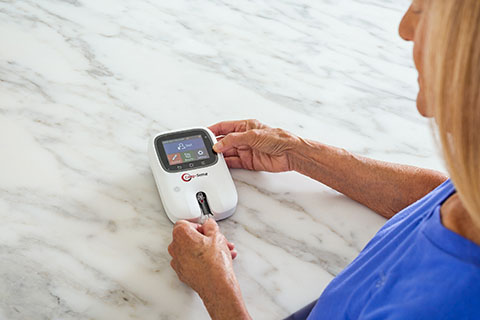Atrial Fibrillation (AFib) is a serious and often silent condition that can significantly increase the risk of stroke. For people diagnosed with AFib, managing the condition and preventing strokes requires careful attention to various factors, including blood thinning therapies. One crucial tool in this process is PT/INR monitoring, which allows patients to track their blood’s clotting ability and ensure their treatment is both effective and safe.
In this blog, we will explore the role of PT/INR monitoring in preventing strokes in individuals with atrial fibrillation and how patient self-testing is transforming healthcare.
What is Atrial Fibrillation (AFib)?
Atrial Fibrillation (AFib) is a common heart condition where the heart’s upper chambers (the atria) beat irregularly and often rapidly, disrupting the normal flow of blood. This erratic heartbeat can increase the risk of blood clots forming in the heart, which may travel to the brain, leading to a stroke.
When left untreated, AFib significantly increases the risk of stroke due to the formation of blood clots. According to the American Heart Association, individuals with AFib are five times more likely to suffer from a stroke than those without it. However, with proper management and regular monitoring, the risk can be greatly reduced.
The Role of PT/INR Monitoring in Stroke Prevention
PT/INR monitoring is an essential tool for individuals with AFib to prevent stroke. PT stands for Prothrombin Time, which measures how long it takes for blood to clot, while INR (International Normalized Ratio) is a standardized measurement used to evaluate the PT and determine whether the blood’s clotting ability is within the desired range.
For patients with AFib, blood thinners, also known as anticoagulants, are often prescribed to prevent clot formation. However, taking blood thinners comes with the risk of bleeding complications. Therefore, regular PT/INR monitoring helps ensure that blood thinning medications are working effectively, while also avoiding excessive thinning that could lead to dangerous bleeding.
How PT/INR Monitoring Works
PT/INR testing involves drawing a small blood sample, usually from the fingertip or arm, to measure clotting time. The results are then used to adjust the dosage of blood thinners, ensuring that it stays within a safe and effective range.
For individuals with AFib, maintaining the correct INR level (usually between 2.0 and 3.0) is essential for preventing stroke. If the INR is too low, the blood may clot too easily, increasing the stroke risk. Conversely, if it’s too high, there’s a risk of bleeding. Therefore, consistent monitoring is key to maintaining optimal levels.
Why PT/INR Self-Testing is a Game-Changer
In the past, patients needed to visit a healthcare provider regularly to have their PT/INR levels tested. However, patient self-testing is now becoming increasingly popular and convenient, enabling patients to monitor their levels from home. With the availability of portable PT/INR testing devices, patients can test their blood at home and report their results to their healthcare provider, who can then adjust medication dosages accordingly.
Benefits of PT/INR Self-Testing:
- Convenience and Accessibility: Self-testing allows patients to monitor their PT/INR levels from the comfort of their home, reducing the need for frequent clinic visits.
- Better Control Over Medication: With regular home testing, patients can maintain better control over their anticoagulant therapy, minimizing the risk of complications.
- Increased Compliance: Studies show that patients who self-monitor their PT/INR levels are more likely to follow their treatment plan and have better long-term health outcomes.
- Time and Cost Savings: Self-testing reduces the time and costs associated with regular doctor visits and laboratory testing.
- Empowerment and Peace of Mind: Patients who are actively involved in managing their condition report feeling more confident and in control of their health
PT/INR Monitoring & Stroke Prevention: The Connection
The relationship between PT/INR monitoring and stroke prevention is undeniable. For individuals with AFib, maintaining an optimal INR level is crucial in preventing blood clots that could lead to a stroke. Regular PT/INR monitoring ensures that the patient is receiving the right amount of blood-thinning medication, which can reduce the risk of clot formation and stroke.
With the rise of self-testing, patients are empowered to take control of their health. Self-testing encourages more frequent monitoring, leading to more precise medication adjustments and reducing the chances of stroke.
The Future of PT/INR Monitoring
The future of PT/INR monitoring is bright, with continuous advancements in technology. Newer and more accurate self-testing devices are being developed, enabling patients to track their blood-clotting levels with greater precision. Additionally, telehealth solutions are making it easier for healthcare providers to receive real-time data from patients, allowing for quicker and more accurate medication adjustments.
As more people adopt self-testing, the medical community will continue to enhance the tools and resources available to patients, making stroke prevention more accessible and effective for everyone.
YOU MAY READ OUR OTHER BLOGS TOO:
ALCOHOL CONSUMPTION & INR: WHAT YOU SHOULD KNOW
EMPOWERING HEALTH: UNDERSTANDING GENETIC PREDISPOSITION TO CLOTTING THROUGH PT/INR SELF-TESTING
PT/INR TESTING FOR PATIENTS WITH PERIPHERAL ARTERY DISEASE: ENHANCING CIRCULATION AND HEALTH
Conclusion
For individuals with atrial fibrillation, managing the condition and preventing strokes is a matter of life and death. Regular PT/INR monitoring plays a crucial role in ensuring that blood-thinning medications are working effectively while avoiding the risk of bleeding complications. With the introduction of PT/INR self-testing, patients now have the ability to monitor their levels at home, making stroke prevention easier and more accessible than ever before.
By staying on top of their PT/INR levels, individuals with AFib can significantly reduce their risk of stroke, leading to longer, healthier lives. Don’t wait for a warning sign—take control of your health and start monitoring your PT/INR levels today.




